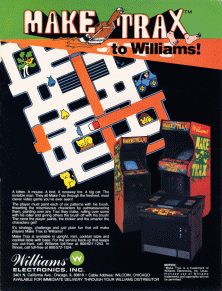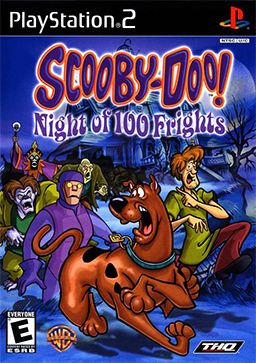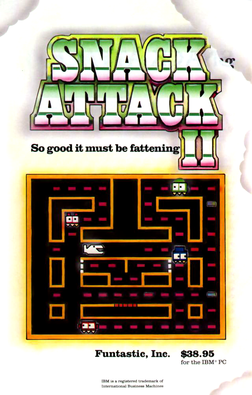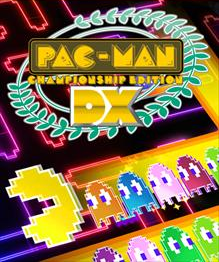
Pac-Man, originally called Puck Man in Japan, is a 1980 maze action video game developed and released by Namco for arcades. In North America, the game was released by Midway Manufacturing as part of its licensing agreement with Namco America. The player controls Pac-Man, who must eat all the dots inside an enclosed maze while avoiding four colored ghosts. Eating large flashing dots called "Power Pellets" causes the ghosts to temporarily turn blue, allowing Pac-Man to eat them for bonus points.
In class-based programming, the factory method pattern is a creational pattern that uses factory methods to deal with the problem of creating objects without having to specify the exact class of the object that will be created. This is done by creating objects by calling a factory method—either specified in an interface and implemented by child classes, or implemented in a base class and optionally overridden by derived classes—rather than by calling a constructor.

Michael Abrash is a programmer and technical writer specializing in code optimization and 80x86 assembly language. He wrote the 1990 book Zen of Assembly Language Volume 1: Knowledge and a monthly column in Dr. Dobb's Journal in the early 1990s. A later book, Zen of Graphics Programming, applied these ideas to 2D and 3D graphics prior to the advent of hardware accelerators for the PC. Though not strictly a game programmer, Abrash has worked on the underlying technology for games, such as Quake, for much of his career. Since 2014, he has been the chief scientist of Oculus VR, a subsidiary of Meta Platforms

Berzerk is a multidirectional shooter designed by Alan McNeil and released for arcades in 1980 by Stern Electronics of Chicago. Following Taito's Stratovox, it is one of the first arcade video games with speech synthesis. Berzerk places the player in a series of top-down, maze-like rooms containing armed robots. Home ports were published for the Atari 2600, Atari 5200, and Vectrex.

Ms. Pac-Man is a 1982 maze arcade game developed by General Computer Corporation and published by Midway. It is the first sequel to Pac-Man (1980) and the first entry in the series to not be made by Namco. Controlling the title character, Pac-Man's wife, the player is tasked with eating all of the pellets in an enclosed maze while avoiding four colored ghosts. Eating the larger "power pellets" lets the player eat the ghosts, who turn blue and flee.

Crush Roller, released as Make Trax in North America, is a 1981 puzzle-maze game developed by Alpha Denshi and released for arcades by Kural Samno Electric in Japan. It was licensed in Europe to Exidy, who released it under its original title Crush Roller, and for North American release to Williams Electronics, who released it as Make Trax.

3D Monster Maze is a survival horror computer game developed from an idea by J.K. Greye and programmed by Malcolm Evans and released in 1981 for the Sinclair ZX81 platform with the 16 KB memory expansion. The game was initially released by J. K. Greye Software in December 1981 and re-released in 1982 by Evans' own startup, New Generation Software. Rendered using low-resolution character block "graphics", it was one of the first 3D games for a home computer, and one of the first games incorporating typical elements of the genre that would later be termed survival horror.

Ms. Pac-Man Maze Madness is a maze chase video game developed and published by Namco for the PlayStation in 2000. It was later released for the Nintendo 64, Dreamcast, and Game Boy Advance. A remake of Ms. Pac-Man (1982), players control the titular character in her quest to stop a witch named Mesmerelda from stealing the Gems of Virtue. The game was well-received upon release, with critics applauding its simplicity and faithfulness to the arcade original. A sequel was in development around 2006, but was cancelled for unknown reasons.

Scooby-Doo! Night of 100 Frights is a third person platform game with action elements that was developed by Heavy Iron Studios and published by THQ for the PlayStation 2, GameCube, and Xbox consoles. The game was released on May 22, 2002, in North America and was released later that year in PAL regions. It was the first Scooby-Doo! video game on sixth-generation consoles. The PlayStation 2 version became a Greatest Hits title in May 2003. The game has a follow up titled Scooby-Doo! Mystery Mayhem.
A maze is a type of puzzle that consists of a complex branching passage through which the solver must find a route.

Advanced Dungeons & Dragons: Treasure of Tarmin is a video game for the Intellivision video game console and the Mattel Aquarius computer system. This game was a licensed Dungeons & Dragons adaptation.
Force field may refer to:

Snack Attack is a maze action video game developed by Dan Illowsky for the Apple II family of computers. It was published by Datamost in 1981.

Snack Attack II is a Pac-Man-inspired maze game released as a self-booting disk for IBM PC compatibles. It was written by Dan Illowsky and Michael Abrash and published by Funtastic in 1982. The game is a sequel to the Apple II game Snack Attack published by Datamost.

Master Miner is a maze shooter for IBM PC compatibles released as a self-booting disk by Funtastic in 1983. It was written by Dan Illowsky who previously wrote Snack Attack for the Apple II. The game involves collecting diamonds while avoiding bandits.
Tower defense (TD) is a subgenre of strategy games where the goal is to defend a player's territories or possessions by obstructing the enemy attackers or by stopping enemies from reaching the exits, usually achieved by placing defensive structures on or along their path of attack. This typically means building a variety of different structures that serve to automatically block, impede, attack or destroy enemies. Tower defense is seen as a subgenre of real-time strategy video games, due to its real-time origins, even though many modern tower defense games include aspects of turn-based strategy. Strategic choice and positioning of defensive elements is an essential strategy of the genre.
Armoredcar or vehicle may refer to:

Pac-Man Championship Edition DX is a 2010 maze video game published by Namco Bandai Games for the Xbox 360 and PlayStation 3, later ported to Steam and iOS. It is the sequel to the 2007 game Pac-Man Championship Edition, which was the last game developed by series creator Toru Iwatani. The player controls Pac-Man as he must eat all of the dots in the maze while avoiding colored ghosts that pursue him. A bonus item will appear once the player has eaten all dots on one side of the maze, causing the layout to change. Several additions were made over the original, such as bombs that send all ghosts to the regeneration box and sleeping ghosts that will give chase when Pac-Man moves past them.












